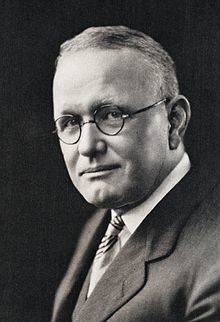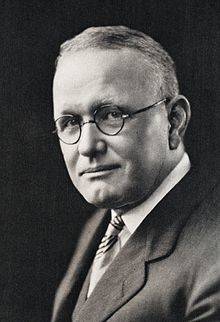

EATON — Chances are you’ve never heard of William Alfred Webb. Over a century ago Webb left Eaton with his mother Nannie and became a successful railwayman. His career spanned decades and continents.
In 1875 Nancy Lavina Campbell — better known as Nannie — and father William Porter Webb were married in Eaton. Young Webb arrived a few years later in May 1878 and, in 1881 his father Porter graduated as a doctor from the Medical School of Ohio in Cincinnati.
As Porter bought a druggist and tried to make it a success, Webb attended Eaton Primary School (South) in Miriam Tuttle’s grade one class. However, the end of the decade saw the end of a marriage: according to family legend Nannie divorced Porter for drunkenness. Nannie and Webb headed to Colorado Springs in 1890 and Porter, well he stayed in Eaton and was later arrested and found guilty for his involvement in an illegal abortion that resulted in a local woman’s death. This charge was later set aside due to lack of evidence but Webb still had to endure months in prison. He fled to Chicago where he died in 1898. Nannie and William ended up in Colorado Springs because one of Nannie’s brothers — Dr William Armstead Campbell — had just moved there with his family. If family legend is true, then perhaps because Colorado Springs the ideal destination because it was a ‘dry’ town and only permitted liquor to be served from 1933 at the end of Prohibition. Webb soon found a job as messenger boy for the Colorado Midland Railroad and thus began a multi-decade railway career. He rose quickly through the ranks, taking courses in telegraphy and stenography to get ahead. It was the Gilded Age of America, an intoxicating time of hustle that Webb embraced with gusto. At the turn of the century he began working for the Colorado & Southern Railroad and based in Denver. This is where his career skyrocketed. He became the assistant to railway Vice President Alexis Du Pont Parker and President Nathan Trumbull. These millionaires mentored William and became de-facto father figures. In those days, assistants had great power and regularly made important business decisions on behalf of the person they represented. Webb’s business acumen and work ethic made him a valuable and trusted asset.
In 1911 Webb became General Manager of the small Texas Central Railroad based in Waco, Texas. Within a year he was head of the Missouri, Kansas and Texas Railway of Texas (a subsidiary of the ‘Katy’ responsible for operations in Texas) based in Dallas and equally rapidly he became head of the whole Katy network that stretched from St Louis Missouri to Kansas City Kansas, and Dallas Texas. For the rest of the decade he operated at this executive level. He was involved in rehabilitating the railway network and improving service even while the Katy was placed in receivership. In 1918 his career faltered as the US Railroad Administration (USRA) — a plan by President Woodrow Wilson to make railways more efficient during time of war — added yet another layer of bureaucracy to the byzantine arrangement of private railroad ownership. Webb was forced to resign for reasons unknown — no doubt related to the friction created by the usurping federal body — only to take an USRA committee position in Washington in early 1919. He left that to head up the St Louis Southwestern Railroad only to resign in protest after a year because he refused to fire members of his team. His loyal staff submitted their resignations en masse and the Cotton Belt Route in Texas suddenly lost most of its operating group in one fell swoop. In late 1922 Webb became President of the Cambria & Indiana Railway in Pennsylvania but he bickered with the majority share owner who was more interested in his coal interests than playing with his train set. By mid-1922 Webb was desperate for an exit plan and he found one where he least expected to find it — on the other side of the world in Australia — and became a superman in the process.
In the early 1920s the South Australian Railways were in poor shape after decades of neglect. In 1922 newly elected Premier Henry Barwell toured the world desperately looking for a ‘superman’ to take control and fix the network. On a damp New York day in June 1922, at the end of a long and frustrating search, the Premier found himself interviewing Webb and suddenly, Barwell discovered a hero (and Webb found a way out of messy situation in Pennsylvania). Just like what his mother did way back in 1890, Webb uprooted his own family — wife Alice, mother Nannie and two sons John and Bill — and travelled much further west to Adelaide, South Australia for a new life. Arriving in November 1922 — with over 90 large wooden cases of chattels and a disassembled 1919 Cadillac as freight — Webb immediately got to work. For the rest of the decade he set about rehabilitating and improving the rail network of South Australia. He spent many thousands of pounds purchasing 30 large locomotives and building a brand-new central railway station. He hired and fired, restructured the administration and improved service. He also enjoyed the highest salary of any public officer in the state, including that of the Premier and Governor. But the shadow of the Great Depression grew darker and his opponents relentlessly attacked his expedients and promises. He left in 1930 with some praising his business skills and others cheering his departure, glad to see him leave. His bureaucratic changes were reversed but his legacy of iron and steel could not be easily undone. The state carried a massive debt load from his expenditure and which was exacerbated by the world-wide depression. But Webb’s work in rebuilding the rail network place the state on a good foundation for the next 25 years, allowing it to shoulder the burden of a conflict that was World War II. By this time sons John and Bill had left home and Nannie had died in 1929 so wife Alice and William returned to Denver then quickly moved to Texas. Webb hated being idle and could not stand being retired — golfing and drinking were fine in small does — so he ran for office and became a Dallas city councillor for two years. He then found himself working for the Texas Centennial Exhibition in a minor role until October 1935 when he was appointed General Manager of the then-foundering event. The Exhibition was significant for a state – and country – in the grip of the Great Depression and the midst of the Dust Bowl. Webb used his business-savvy to turn the organisation around, making what publicly seemed an imminent disaster into a success. Working 14plus hour days during both a wretched winter and record-breaking summer; making on-the-spot decisions and travelling across the grounds on horseback galvanised the workforce and the event opened on time in early June 1936. This effort killed him. On Saturday August 8 he suffered a massive stroke at work but somehow was able to drive himself home. He survived the night and was taken to hospital Sunday only to experience another heart attack. His poor health was no surprise to his family or medical staff but he had concealed his sickness from the public for the last two years, unwilling to tarnish the Centennial with his illness. He died Sunday afternoon aged 58. So now you know about all William Alfred Webb, the superman of Eaton.
(Author profile and acknowledgement: Peter Buske lives and writes half a world away in Adelaide, South Australia. From this great distance he is trying to figure out what made Webb tick and now that you know all about Webb you may be able to help. In your attics and front rooms, in the hallway or in photo albums, you may have a memory of William Webb or his parents Nannie Campbell and Porter Webb. It could be a postcard, letter, diary or photograph from one of your ancestors who just happened to be Willie Webb’s best friend at school and played hide and seek as the lazy summer sun set, and exchanged snowballs with him in winter. If you have something like this and are willing to share it, Peter would be delighted if you contacted him. Assistance from the Preble County District Library is gratefully acknowledged in the preparation of this article.)


